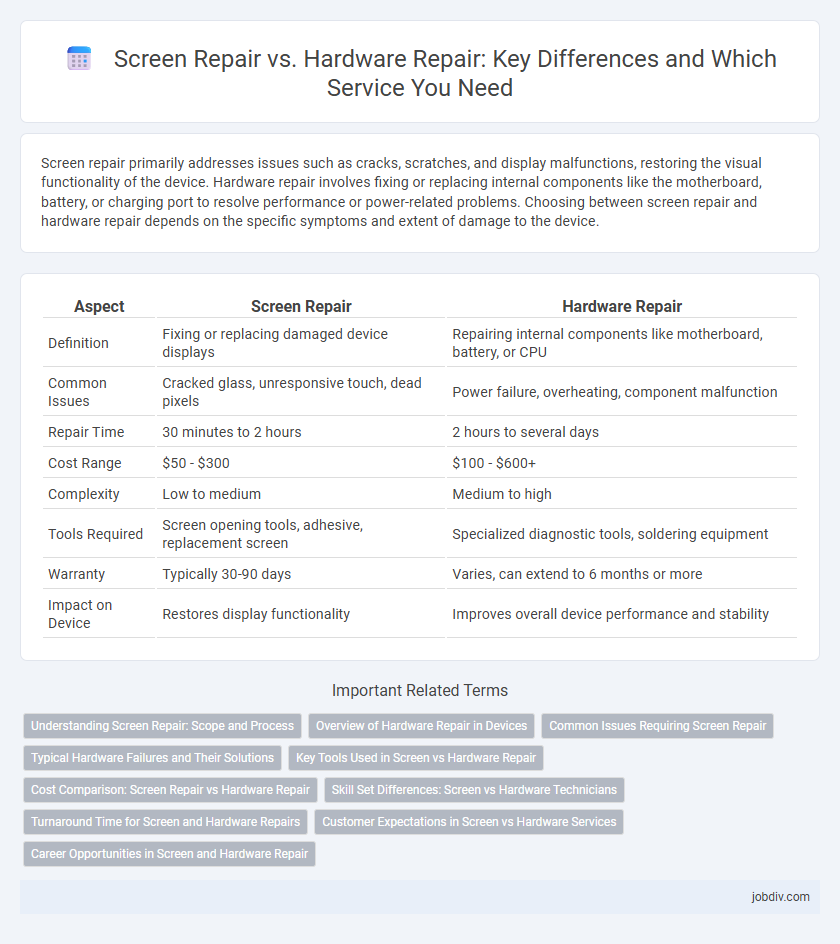Screen repair primarily addresses issues such as cracks, scratches, and display malfunctions, restoring the visual functionality of the device. Hardware repair involves fixing or replacing internal components like the motherboard, battery, or charging port to resolve performance or power-related problems. Choosing between screen repair and hardware repair depends on the specific symptoms and extent of damage to the device.
Table of Comparison
| Aspect | Screen Repair | Hardware Repair |
|---|---|---|
| Definition | Fixing or replacing damaged device displays | Repairing internal components like motherboard, battery, or CPU |
| Common Issues | Cracked glass, unresponsive touch, dead pixels | Power failure, overheating, component malfunction |
| Repair Time | 30 minutes to 2 hours | 2 hours to several days |
| Cost Range | $50 - $300 | $100 - $600+ |
| Complexity | Low to medium | Medium to high |
| Tools Required | Screen opening tools, adhesive, replacement screen | Specialized diagnostic tools, soldering equipment |
| Warranty | Typically 30-90 days | Varies, can extend to 6 months or more |
| Impact on Device | Restores display functionality | Improves overall device performance and stability |
Understanding Screen Repair: Scope and Process
Screen repair primarily involves fixing or replacing the display components such as the LCD, digitizer, and glass to restore visual functionality. This process includes diagnosing screen damage, carefully removing broken parts, and installing new components to ensure touch sensitivity and display clarity are fully recovered. Screen repair typically addresses issues like cracks, dead pixels, and unresponsive touch, distinguishing it from broader hardware repairs that encompass internal components like batteries, circuit boards, and connectors.
Overview of Hardware Repair in Devices
Hardware repair in devices involves fixing or replacing physical components such as motherboards, batteries, and connectors that are essential for device functionality. Unlike screen repair, which targets display-related issues like cracks or dead pixels, hardware repair addresses internal malfunctions and damaged parts affecting performance. This process often requires specialized tools and expertise to ensure the longevity and reliability of the device's overall system.
Common Issues Requiring Screen Repair
Cracked screens, unresponsive touch functionality, and dead pixels are the most common issues requiring screen repair in smartphones and tablets. Screen damage typically results from accidental drops, pressure, or exposure to liquids, affecting the device's display quality and usability. Repairing the screen is often more cost-effective and faster than comprehensive hardware repair, which involves internal components like the motherboard or battery.
Typical Hardware Failures and Their Solutions
Typical hardware failures include broken screens, faulty batteries, damaged charging ports, and malfunctioning buttons. Screen repair often involves replacing cracked or unresponsive displays using specialized tools to restore touch sensitivity and visual clarity. Hardware repair addresses issues like battery replacement, fixing damaged connectors, or repairing internal components to ensure device functionality and prolong lifespan.
Key Tools Used in Screen vs Hardware Repair
Screen repair primarily relies on precision tools such as suction cups, plastic pry tools, and specialized screwdrivers to safely remove and replace glass panels or LCDs without damaging internal components. Hardware repair, on the other hand, demands a broader set of instruments including multimeters for electrical diagnostics, soldering irons for circuit board fixes, and anti-static mats to prevent component damage. Both repair types require magnifying devices and adhesive materials, but hardware repair emphasizes electronic testing and component-level intervention.
Cost Comparison: Screen Repair vs Hardware Repair
Screen repair typically costs between $100 and $300 depending on the device model and screen type, often making it more affordable than hardware repair. Hardware repair expenses vary widely, ranging from $150 to over $1,000, influenced by the complexity of the internal components such as motherboard or battery replacements. Choosing screen repair usually provides a cost-effective solution for visible damage, while hardware repair may require higher investment due to intricate diagnostics and part replacements.
Skill Set Differences: Screen vs Hardware Technicians
Screen repair technicians specialize in handling delicate display components, requiring expertise in pixel alignment, glass replacement, and touch sensitivity calibration. Hardware repair technicians possess a broader skill set focused on diagnosing and fixing internal components like motherboards, processors, and connectors, demanding proficiency in soldering and electronic circuit analysis. These distinct skill sets emphasize precision in screen repairs versus comprehensive hardware troubleshooting.
Turnaround Time for Screen and Hardware Repairs
Screen repair turnaround time typically ranges from 30 minutes to a few hours, offering a quick resolution for cracked or unresponsive displays. Hardware repairs involving internal components like motherboards or batteries often require 1 to 3 business days due to complexity and part availability. Fast screen repairs minimize device downtime, while hardware fixes ensure long-term functionality despite longer service periods.
Customer Expectations in Screen vs Hardware Services
Customers expect screen repair services to be fast, affordable, and restore full visual clarity without affecting touch sensitivity. In hardware repair, expectations shift towards precise diagnostics, reliable component replacement, and long-term functionality of internal parts. Clear communication about repair scope and warranty policies significantly influences customer satisfaction in both service types.
Career Opportunities in Screen and Hardware Repair
Careers in screen repair offer specialized opportunities in LCD, OLED, and touchscreen technology, focusing on troubleshooting display issues and delicate component replacement. Hardware repair careers encompass a broader scope, including motherboard diagnostics, battery replacement, and peripheral repairs, appealing to those interested in comprehensive device maintenance. Both fields present growing demand due to increasing reliance on electronic devices, with hardware repair often commanding higher technical expertise and screen repair providing rapid, high-volume service options.
Screen Repair vs Hardware Repair Infographic

 jobdiv.com
jobdiv.com